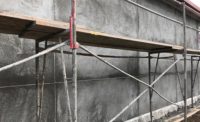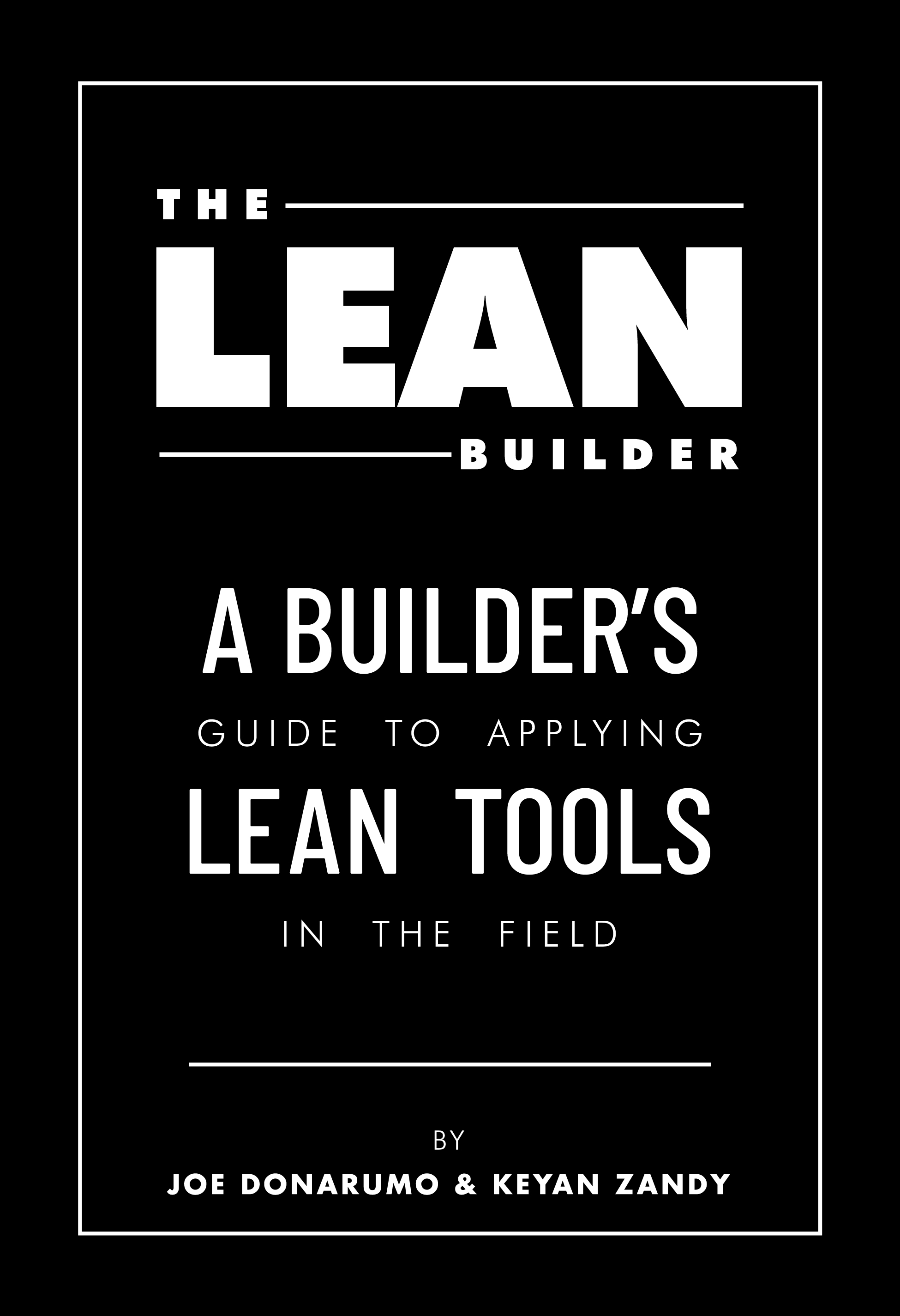Gone With the Wind

These new plaster walls
were exposed to extreme wind gusts in the desert. Horizontal cracks were
noticed shortly afterwards.
Structural engineers and plaster bureaus that have tried to define the forces that impact the performance of Portland cement have had challenges, particularly when investigating why the cement stucco has developed cracks. This article is a collaborative effort of a structural engineer and plaster bureau representative who met and decided it was time to work together. Both have investigated many cement plaster projects with unsatisfactory conclusions as to why apparently good stucco systems were still cracking excessively. It was decided to put some science to the investigation into stucco cracks and go beyond the normal finger pointing at each other.

An
unexplainable horizontal crack.
Plastering contractors tend to get blamed for almost everything that can go wrong with an exterior. If the framing is out of plum, builders tend to blame plasterers for not varying thickness in cement to straighten the wall. If the plasterer straightens the wall, he gets blamed for varying the thickness in the cement plaster. Sometimes, it seems a no win situation. Cracks in the stucco are almost always blamed on the plastering contractor, not enough curing, too much cement, too much curing, too much lime, too much water, not enough water and so on. Rarely, if ever, does any general contractor, architect or engineer even think it could be something “they” may have possibly overlooked.
First and foremost, a properly mixed and applied cement plaster should be resistant to most cracking. Not curing plaster will produce a weak plaster panel, and improper installation of lath attachments, trim and expansion or control joints can create cracking. Not following our plastering industry installation standards can also create excessive cracking, and this certainly happens. But what if the lather and plasterer does everything right or at least really well? Every single step is monitored and complies with industry standards and the plaster still cracks excessively?
This article deals with two items rarely even considered when investigating cracks in stucco and because of the research of structural engineer Moore, maybe we should not be focused solely on one suspect. First, environmental conditions can create more stress than a proper cement plaster can resist. Second is the choice of wood materials in framing construction and how they can affect stucco performance. These two factors, according to Moore, have a more significant effect on cement plaster than previously thought.

Crack
in stucco suspected from use of economy lumber.
OUT OF PLANE WIND LOADS
All buildings are designed to resist wind and earthquake loads. These loads are determined from state and national building codes. The International Building Code and newly adopted California 2007 California Building Code, reference ASCE 7-05 (American Society of Civil Engineers), a standard which defines Minimum Design Loads for Buildings and Other Structures, Chapter 6. Previous codes defined wind velocities based upon a fastest mile wind speed. A fastest-mile wind speed is the highest sustained average wind speed based on the time required for a mile-long sample of air to pass a fixed point.The new codes require wind loads to be based upon a three-second gust speed. A three-second gust wind speed is the average speed of the wind during a three-second interval. Duration of the fastest-mile is the time it takes a volume of air to travel one mile. At 80 mph, the duration would be about 45 seconds. The three-second gust wind speed, on the other hand, is measured over a much shorter time period. The three-second gust measurement is more direct, immediate and resembles more of what really happens on real life projects. Moore believes that these high intensity wind gusts may be more responsible for cracking in plaster panels than anyone ever thought.

Aluminum
reveals can expand and contract in extreme temperature swings.
Starting in 2008 the ASCE 7-05 Section 6.5 requirement will govern the “components and claddings” with regard to design and wind pressures. Wind loads for walls are inward pressures or outward suction pressures exerted by wind flowing over and around a building which varies with time, location (and orientation) of the building. The highest pressures occur over small areas for a very short time period on building regions where the wind flow is quite significant. For example, in regions near the corner of the building, according to the old code, wind forces are considered 25 percent higher than the field between the corner portions of the walls.
This means that a two-story residence with a fairly steep roof will experience higher wind forces than a one-story residence with an average sloped roof. Further the windward pressures are to have the same pressure coefficient (Cq) for the full width of the building, include the combined height, exposure and gust factor (Ce) pressures vary all depending upon the height above the ground.
This means any stucco building being reviewed currently, using exterior engineered shear walls and any portion of that wall connected to the shear wall is considered an element of component and claddings per the code. Therefore the wall is to be designed to all of the requirements of Sections 1613-General and Section 1615 in the code rather than Division IV-Section 2320-Conventional Light-frame Construction Design Provisions.
The guidelines for Portland cement plaster should be defined not just in terms of deflection criteria (L/360) but also how much resistance is required in the framing to keep the walls from fluttering in and out even a small distance. Big winds can blow buildings apart. Medium winds will not blow buildings apart, but if the walls are not designed sufficiently, the wind can cause the walls to flutter and the cement stucco will crack. The building is structurally safe, and this is not a life/safety issue, but the aesthetic integrity of the Portland Cement Plaster exterior is compromised and that seems to garner more attention from building owners. The aspect of design neglected is consideration of the fact that “excessive deflections or rotations,” which may affect the appearance or functional use of the structure may and do cause damage to non-structural elements like exterior claddings.
In Henderson, Nev., another study was performed where velocity transducers measured wall movement responses from wind gusts between 28 mph and 40 mph. The cracks in the stucco did move approximately 250 micro-inches illustrating wall deflection caused from the wind gusts.

Cracking
in plaster may be caused be
wind loads.
WE'RE NOT OUT OF THE WOODS YET
The quality of lumber used on projects may be the most overlooked item during construction and is certainly overlooked when persons are investigating cracks in walls with cement stucco. Neil Moore has learned not to overlook this important factor and to avoid potential pitfalls that can affect plaster performance. Low strength and low quality stud grades such as Douglas Fir “Standard,” a Fir-stud or Douglas Fir No. 3, have a low stiffness modulus. These economy studs save initial construction costs, but can impact the plaster performance.Quite simply, the stiffer the stud, the less the stud will deflect. In all cases, the labor cost is approximately the same and the initial saving is only in the cost of the stud. There are also variations in the stiffness (modulus of elasticity) between individual pieces of lumber. Paraphrasing NDS, in certain applications where deflection (or more precisely a lack of deflection) may be critical, such as may occur in closely engineered, innovative structural components or systems, use of a reduced modulus of elasticity value may be deemed appropriate by the designer.

Unexplainable
horizontal cracks in large panels may be a sign of out of plane wind loading.
In Portland Cement Plaster seminars, industry experts recommend that the roof (especially concrete tile roofing) be installed prior to plastering. Some literature suggests that there should be a waiting period of a few days prior to installing the base coat (scratch and brown coat) to allow the building to accommodate the weight and settle. Industry experts like to suggest that the reason for pre-loading roofs is based on crushing of the sill plates. Presuming that a sill plate is Hem-Fir and the top plates and 2x4 studs are Douglas fir and the wall is loaded to around 1,900 pounds, the crushing of the combined two surfaces could be around .07 of an inch. This defines our use of the term, “the house is squatting.” To be more precise, the contact point or origination point for that compression stress from sill crushing is where the plaster abuts the underside of the roof plywood at the top of the wall. The other indicator of sill crushing in the crack pattern of three-coat stucco is the continuous tight vertical crack radiating down from under the eaves of the house.
Additional sill crushing can also be a result of direct wind pushing the wall inward which rotates the stud and crushes the inside portion of the sill plate. When the wall returns to its original position the sill bearing area is reduced and the vertical dead load crushes the sill additionally. When the wall deflects outward and the bottom of the stud rotates from the suction force of the wind pulling the wall outward, the outside portion of the sill plate is crushed. This continues to equilibrium of the sill and compression of the sill until it can resist the crush force.
The resultant cracking and premature deterioration of what should be a long lasting durable exterior cladding can sometimes be attributed to conditions beyond the plastering industry’s control. Investigating, testing and working with code bodies and designers in an attempt to provide more acceptable, robust substrates coinciding with developing plaster panels with greater flexural strength, can hopefully serve us all well in the long run.
For contractors in wood frame construction, there are a few ways to minimize cracking in these high production environments. Suggest that your builder use kiln dried lumber rather than only a 19 percent moisture laden lumber. This kiln dried lumber can help minimize cracking in three-coat stucco walls. If a general contractor refuses to load the roofs, gypsum wallboard or other heavy materials prior to plastering, the plastering contractor may be advised to install a casing bead and a minimum 3/8 inch flexible joint along the eaves to accommodate the anticipated shrinkage. This is not the plasterer’s responsibility, just another precautionary step if a builder is unwilling to accept his responsibility. Why would a plasterer do this? Litigation is a fact of life in the plastering industry. All cracking has wrongfully been defined as a wall defect, envelope failure, and potential source of a leak.
Anytime we can add to our library of events that impact our brittle exteriors the better we can defend our industry and our products. W&C
Looking for a reprint of this article?
From high-res PDFs to custom plaques, order your copy today!





.jpg?height=200&t=1646937195&width=200)


